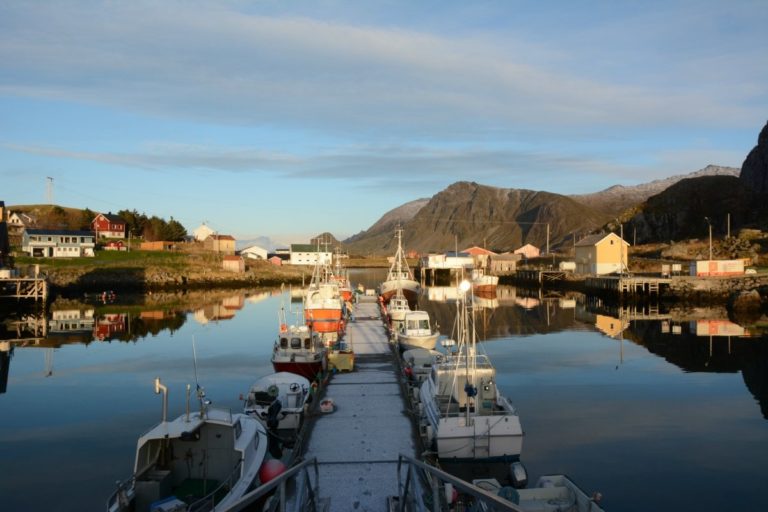Bø is in an isolated location on the west side of Langøya, the biggest island in Vesterålen. Few tourists find their way out here, since it’s not on the way to anywhere else – and that’s the very reason why you should make the trip. From the Vesterålen metropolis of Sortland, it takes an hour to drive from the green and pleasant fjord and mountain landscape to this tough, barren, weather-beaten outer coast.
Make sure to take the detour to Hovden
From Malnes, you can take a detour north to Hovden. This is a stretch of coastline with a dramatic, barren landscape that is in stark contrast to the greener and more fertile area around Straume and Vinje. This is probably the area that makes the strongest impression, and it is a place that you really cannot miss. The landscape and settlements are what make the biggest impression, more so than museums and attractions.
Practical information about Bø in Vesterålen
Bø is located on outermost Langøya island in Vesterålen. The best way to get there is by car, entering the island by crossing the bridge from Hinnøya island to Sortland and following the 820 route northward and then westward to the outer coast. If travelling by Hurtigruten it is possible to get off at Stockmarkness and drive the Fv82 route northward before joining the 820 route. If you are flying you can take a flight to Stockmarkness and follow the same instructions. There is a car rental service in Stockmarkness where they can give you more advice on driving conditions and routes.
Yes, there are plenty of accommodation option in Bø along with some great restaurants. Often these places include activities such as kayaking, photo safaris, hiking tours and deep sea fishing, and Bø is also a great place to watch the Northern Lights.
For all the information you need about Vesterålen you can check out the Visit Vesteralen webpage with contact information to get help planning your trip.
The bird filled cliffs of Nykan loom over the fishing community of Nykvåg
The cliff formation at Nykan with its bird cliffs is a striking feature along the route, with its column-like peaks rising out of the sea. Puffins, razorbills, guillemots and kittiwakes breed here. The seabird population in the area is several hundred thousand pairs. If you drive down towards Nykvåg, you will see colourful houses in a relatively unprotected position facing the open ocean. However, there is a protected harbour with fishing boats nestled into the lee between a crag and a jutting headland. A bird cliff is just outside the settlement, so people and birds live off the same fish out in this rich sea.
Hovden greets you with open ocean, towering mountains and fish racks
Hovden is at the end of the road, and is a picturesque place with an extremely old settlement, huge fish drying racks and a landscape of open ocean and steep mountains. Drive on to the big wind turbine beside the sea, and look down the coast, in towards the steep mountains and out over the endless sea. If you manage to time your visit to catch the sunset or the rays of the midnight sun, you will have a golden moment to remember. At Hovden, there is also the sculptural installation of Ræk III. The Vesterålen artist Harald Oredam used an Icelandic basalt column and driftwood to make this installation. In the local cafe, you digest it all over coffee.
Follow the coastal trail in Bø and Føre where people lived over 1000 years ago
Straume is an important crossroads in Bø, with shops, a café and petrol station. From here, it’s not far to go to Straumsjøen, where the coastal trail in Bø begins. This trail follows the outermost shoreline, and provides uninterrupted sea views and steep mountainsides. Further south is the Iron Age site at Føre. In the 1950s, a number of Iron Age graves were found here, from the period 3–500 AD, and also male artefacts such as swords and female artefacts such as spinning wheels and jewellery. The graves are signposted from the road, and even though you can’t see much today, a walk is still an evocative experience.
The ‘Man from the Sea’ and Bø Museum are must see attractions in Bø
Even further south is the Man from the Sea. This is an enormous sculpture of a 4.3 metre (14 ft) high man looking out to sea. This is part of the ‘Artscape Nordland’ project, and Bø’s contribution is the most sensational. After all, we must believe that the man has chosen to stand there because of the view; due west is the distinctive silhouette of Gaukværøya island, while to the south you can see the entire north side of the Lofoten Wall. Nearby is Bø Museum, which tells the stories both of the fishermen farmers of Bø through old artefacts, and of the popular beliefs and storytelling tradition of this entire coast. There is a special focus on fairy tale writer Regine Normann. A little further south is Skagakaia, where in the summer there is a restaurant and café in an old, intact post office.
Bø Church offers unparalleled views of the landscape
If you follow a winding road around the southern tip of Bø, you will come to Bø Church. This red-painted cruciform church from 1824 has highly irregular opening times, but the view to Stokmarknes, Hadselbrua Bridge, the Lofoten Wall and the roof of Vesterålen, the 1,262 metre (4,140 ft) high Møysalen is never closed. The House at the Outer Edge is a restaurant and tourist complex offering many activities, and the hosts can provide advice about how to get to the top of the 467 metre (1,532 ft) high mountain of Vetten, which is one of the loveliest viewpoints and midnight sun spots in Vesterålen.






